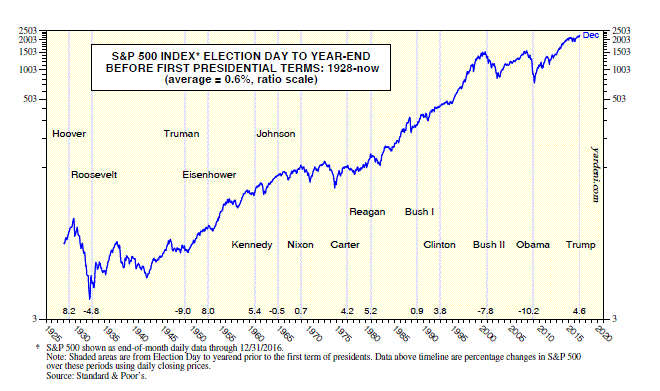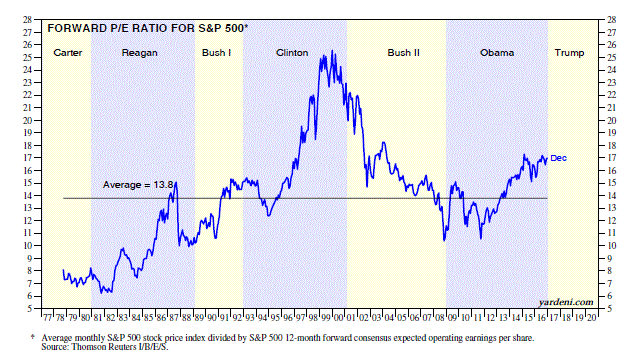
The answer to the question posed in the title of this piece is certainly not “stock investors.” Hopefully, the complete answer is “lots of little piggies afraid of what President-elect Donald Trump might do to them.” Maybe they will cease and desist before they show up in one of the Big Bad Wolf’s tweets. He has already had some success in getting Boeing (NYSE:BA) and Lockheed Martin (NYSE:LMT) to review their costs so that they will lower the prices they charge the government for their high-end products.
Now let’s see if Trump can make some progress in reducing personal and corporate tax rates while eliminating many of the exemptions and deductions that make the tax code a slush fund for lobbyists and their patrons. Let’s see if he can reduce onerous regulations on businesses. Can he do all that while keeping a lid on Federal spending given that there are so many little piggies feeding in the government trough? Let’s hope that the Progressive ones aren’t simply replaced by the crony capitalist variety.
The big question is whether he will succeed in bullying our trading partners to be fairer without instigating a trade war. An even bigger question is whether he can curb the nuclear ambitions of North Korea’s Lil’ Kim and Iran’s Supremes. Then there are China’s ambitions to turn the South China Sea into a secluded lake for their navy. We should also hope that Trump’s reset with the Russian Bear will be more successful than was Obama’s attempt to normalize relations with the beast.
This is a long wish list, and may be biased toward too much wishful thinking. However, we can’t rule out the possibility that Trump will succeed. He certainly has so far, upending the predictions of all his detractors. Betting against him has been a bad bet so far.
That seems to be the message of the stock market. The S&P 500 is up 4.6% from Trump’s Election Day (T-Day) through the end of 2016. That seems impressive, but it isn’t unprecedented. Here are the comparable performance figures for past presidents just elected to their first terms: Hoover (8.2%), Eisenhower (8.0), Kennedy (5.4), Reagan (5.2), Carter (4.2), Clinton (3.8), Bush I (0.9), Nixon (0.7), Johnson (-0.5), Roosevelt (-4.8), Bush II (-7.8), Truman (-9.0), and Obama (-10.2). So Hoover, Eisenhower, Kennedy, and Reagan trumped Trump. Perhaps Trump would have done better if the S&P 500 weren’t already nearly nine years into a bull market with valuation multiples at nose-bleed levels.
Then again, those valuations may not be too high if Trump delivers all the supply-side magic of personal and corporate tax cuts, and they work like a charm. Reagan did the same, but the economy was heading into a severe recession after his first 100 days. Back then, Fed Chairman Paul Volcker was intent on breaking the back of inflation by breaking everyone’s backs with burdensomely high interest rates, and Reagan supported Volcker’s tough love.
Now Trump might do what Reagan did, but with an economy that clearly is growing with no recession in sight. There certainly isn’t enough inflation to cause the Fed to precipitate a recession by tightening monetary policy too aggressively. Volcker raised the Federal funds rate to over 20%. The FOMC’s dot plot suggests that the members of the committee expect to raise the Federal funds rate this year three times at most, by 25bps each time, to 1.50%. The implications for corporate earnings could be awesome, as Joe and I discussed last month. If so, then valuation multiples are simply getting ahead of earnings, but rightly so.
Tuesday’s WSJ included an article titled “Earnings, Not Donald Trump, Are Stocks’ Best Friend in 2017.” That’s not news to us: Joe and I have been predicting since last summer that the end of the Energy-led earnings recession would boost stock prices. The subtitle of the article is:
“Continued rebound in corporate profits should prop up share prices regardless of Washington policies.”
Actually, given that valuations were high before Election Day, and went higher after Trump’s sweeping victory (with his party winning control of both houses of Congress), we believe that his policies will matter a great deal.
If for some unanticipated reason he fails to implement his tax cuts and to cut regulations, stocks would take a dive. They might even crash if he manages to start a trade war. If he succeeds in his plans, then the S&P 500 earnings growth could more than double from 9% this year to 19%, as Joe and I explained last month. So Washington matters a great deal this year.
After Reagan was elected to his first term, the forward P/E of the S&P 500 rallied to 7.7 in February 1981 from a Jimmy (“Malaise”) Carter low of 7.0 during November 1979. During 1982, it dropped to a low of 6.3. During Reagan’s second term, it rose to a high of 14.8 during August 1987. On Tuesday, the S&P 500’s forward P/E was 16.9, well above the 13.8 average from September 1978 through December 2016. The forward P/Es of the S&P 400/600 were even closer to the sun at 18.7 and 19.8.
For the S&P 500, if the index price remains unchanged at the current level through the end of the year, a 10% increase in earnings this year would lower the multiple to 15.4, while a 20% increase in earnings would lower it to 14.1. So, yes, the multiples are high, as investors have gotten ahead of earnings. But earnings could do some significant catching up if Trump’s program boosts earnings as much as Joe and I expect. If the multiple stays put and earnings increase 20% as a result of tax cuts, then the S&P 500 would rise to 2700. For now, we are sticking with 2400-2500 as our target for this year.

